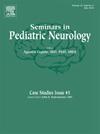Review of encephalocraniocutaneous lipomatosis
IF 2.1
4区 医学
Q2 CLINICAL NEUROLOGY
引用次数: 0
Abstract
Encephalocraniocutaneous lipomatosis (ECCL), also known as Haberland syndrome, is a sporadic tumor predisposition neurocutaneous disorder, included in the oculoectodermal syndrome group of mosaic RASopathies. ECCL primarily affects the skin, central nervous system and eyes. Key diagnostic features include nevus psiloliparus, a hallmark subcutaneous lipomatous hamartoma associated with alopecia, along with subcutaneous lipomas, focal skin aplasia, and patchy alopecia. Neurologically, intracranial lipomas, particularly in the cerebellopontine angle, are prevalent, along with cortical dysplasia, ventriculomegaly, and vascular malformations. Ocular findings commonly involve choristomas, lipodermoids, and dermoids, which may impair vision. Diagnosis can be made clinically, but further confirmatory genetic testing can in some cases identify a pathogenic variant in the FGFR1 or KRAS genes. Molecular testing aids diagnosis but is not always conclusive.
Management is multidisciplinary with focus on symptomatic management, typically involving dermatological, neurological, and ophthalmologic evaluations with consideration of brain and spine neuroimaging and surgical management of tumors. The prognosis varies, with most individuals leading generally normal lives, though there is a risk of developmental delay, seizures, and low-grade gliomas. The severity of CNS involvement does not consistently correlate with cutaneous or ocular abnormalities.
脑-颅-皮脂肪瘤病的研究进展
脑皮脂肪瘤病(ECCL),也称为Haberland综合征,是一种散发的肿瘤易感性神经皮肤疾病,属于花叶性RASopathies的眼外胚层综合征组。ECCL主要影响皮肤、中枢神经系统和眼睛。主要的诊断特征包括:裸眼痣,一种与脱发相关的标志性皮下脂肪瘤错构瘤,以及皮下脂肪瘤、局灶性皮肤发育不全和斑状脱发。神经学方面,颅内脂肪瘤,尤其是桥小脑角,是普遍存在的,同时伴有皮质发育不良、脑室肿大和血管畸形。眼部表现通常包括脉络膜瘤、脂质皮样和真皮样,可损害视力。可以进行临床诊断,但在某些情况下,进一步的确证性基因检测可以确定FGFR1或KRAS基因的致病性变异。分子检测有助于诊断,但并不总是决定性的。管理是多学科的,重点是症状管理,通常涉及皮肤病学,神经学和眼科评估,考虑到脑和脊柱神经影像学和肿瘤的外科治疗。预后各不相同,尽管存在发育迟缓、癫痫发作和低级别胶质瘤的风险,但大多数人的生活一般正常。中枢神经系统受累的严重程度与皮肤或眼部异常并不一致相关。
本文章由计算机程序翻译,如有差异,请以英文原文为准。
求助全文
约1分钟内获得全文
求助全文
来源期刊

Seminars in Pediatric Neurology
CLINICAL NEUROLOGY-PEDIATRICS
CiteScore
4.80
自引率
0.00%
发文量
38
审稿时长
84 days
期刊介绍:
Seminars in Pediatric Neurology is a topical journal that focuses on subjects of current importance in the field of pediatric neurology. The journal is devoted to making the status of such topics and the results of new investigations readily available to the practicing physician. Seminars in Pediatric Neurology is of special interest to pediatric neurologists, pediatric neuropathologists, behavioral pediatricians, and neurologists who treat all ages.
 求助内容:
求助内容: 应助结果提醒方式:
应助结果提醒方式:


